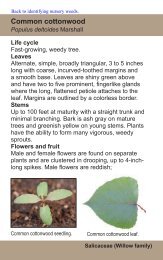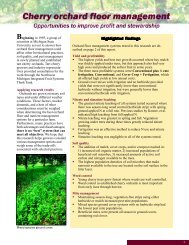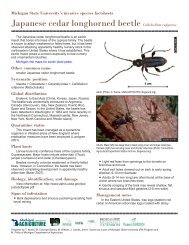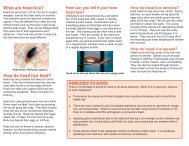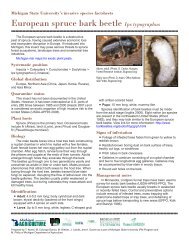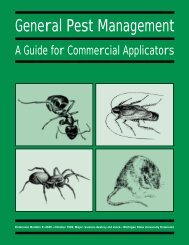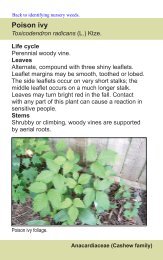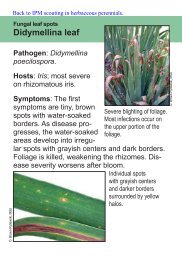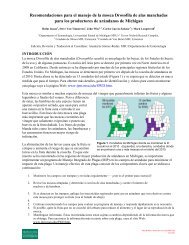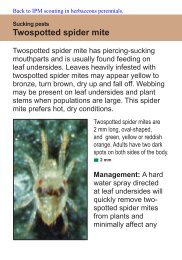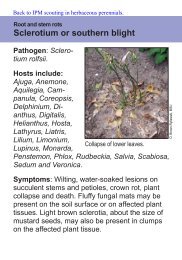CALIBRATION
CALIBRATION
CALIBRATION
Create successful ePaper yourself
Turn your PDF publications into a flip-book with our unique Google optimized e-Paper software.
will not double the flow rate–you must increase the pressure<br />
fourfold to double the flow rate.<br />
Sprayer pressure<br />
(speed constant)<br />
Sprayer output<br />
(gallons per acre)<br />
10 psi 10<br />
40 psi 20<br />
160 psi 40<br />
Pressure cannot be used to make major changes in<br />
spray rate, but it can be used to make minor changes.<br />
Keep in mind that operating pressure must be maintained<br />
within the recommended range for each nozzle<br />
type to obtain a uniform spray pattern and minimize<br />
drift.<br />
The easiest and most effective way to make a large<br />
change in flow rate is to change the size of the nozzle tips.<br />
Depending on operating pressure, the speed of the<br />
sprayer, and nozzle spacing, small changes in nozzle size<br />
can significantly change sprayer output per acre. Use nozzle<br />
manufacturers’ catalogs to select the proper tip size.<br />
Ground Speed of the Sprayer<br />
Provided the same throttle setting is used, as speed<br />
increases, the amount of spray applied per unit area<br />
decreases at an equivalent rate. For example, doubling<br />
the ground speed of a sprayer will reduce the amount of<br />
spray applied by one-half.<br />
Sprayer speed<br />
(under constant pressure)<br />
Sprayer output<br />
(gallons per acre)<br />
1 mph 40<br />
2 mph 20<br />
3 mph 13.3<br />
4 mph 10<br />
To determine the new output after changing speed:<br />
old output x old speed<br />
New output =<br />
new speed<br />
Some low-pressure sprayers are equipped with control<br />
systems that maintain a constant application rate over a<br />
range of travel speeds, provided the same gear setting is<br />
used. Pressure is automatically changed to vary the nozzle<br />
flow rate in proportion to changes in ground speed.<br />
Even so, do your calibration at a set ground speed. In the<br />
field, travel speed must be kept within certain limits to<br />
keep the nozzle pressure within the recommended range.<br />
Precalibration Check of Nozzle Output<br />
After making sure the system is clean, fill the tank<br />
approximately half full with water. Fasten a graduated<br />
container under each nozzle and operate the sprayer for<br />
one minute at a pressure within the recommended<br />
pressure range. Check to see that the flow rate from each<br />
nozzle is approximately the same; replace or clean any<br />
nozzle whose output differs by more than 5 percent from<br />
the average for all of the nozzles and again check the<br />
flow rates.<br />
For example, the following flow rates are obtained for<br />
six nozzles:<br />
Nozzle<br />
Output (ounces per minute)<br />
1 40.0<br />
2 43.0<br />
3 39.5<br />
4 40.5<br />
5 37.5<br />
6 39.5<br />
Total 240.0 ounces<br />
The average nozzle output is 40 ounces (2406).<br />
Five percent of 40 ounces (40 x 0.05) is 2 ounces. Any<br />
nozzle whose output differs from 40 ounces by more than<br />
2 ounces should be cleaned or replaced; that is, any nozzle<br />
whose output is greater than 42 or less than 38.<br />
Therefore, nozzle #5 should either be cleaned or replaced.<br />
The flow rate of nozzle #2 is too high. This indicates that<br />
the nozzle is worn and should be replaced.<br />
When the average nozzle output varies by more than<br />
10 percent from the manufacturer’s specifications, the<br />
nozzles are worn enough to justify the purchase of a new<br />
set. This is particularly important when using flat-fan or<br />
flood nozzles because proper spray overlap becomes difficult<br />
to maintain with worn nozzles.<br />
Spray Pattern Uniformity<br />
A uniform spray pattern is crucial for an effective pesticide<br />
application. It’s not enough to apply a pesticide<br />
only in its correct amount–you also must apply it uniformly<br />
over the target area. The effects of non-uniform<br />
application are most obvious when herbicide bands overlap<br />
and streaking results. Spray pattern uniformity is<br />
affected by boom height, spacing and alignment of nozzles<br />
on the boom, condition of nozzles (worn, damaged),<br />
and operating pressure. Check that all nozzles are of the<br />
same type. Also, a frequent cause of poor spray patterns<br />
is using nozzles with different spray angles on the same<br />
boom.<br />
To check the uniformity of the spray pattern, adjust the<br />
boom height for the spray angle and nozzle spacing<br />
being used. Align flat-fan nozzles at a slight angle to the<br />
boom. Using water, operate the sprayer at the desired<br />
speed and pressure on clean, dry pavement or on another<br />
smooth surface. Observe the spray pattern as the water<br />
evaporates. Clean or replace nozzle tips that produce a<br />
poor spray pattern; if necessary, readjust boom height<br />
and recheck the spray pattern. If you replace any nozzles,<br />
recheck the flow rates.<br />
Chapter 4<br />
26<br />
Field Crop Pest Management



